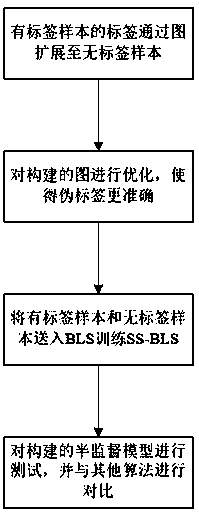Electroencephalogram signal classification method based on graph semi-supervised width learning
A technology of EEG signals and classification methods, applied in the field of pattern recognition, can solve problems such as complex structure adjustment and massive calculations
- Summary
- Abstract
- Description
- Claims
- Application Information
AI Technical Summary
Problems solved by technology
Method used
Image
Examples
Embodiment Construction
[0049] The present invention is described in detail below in conjunction with accompanying drawing based on graph semi-supervised width learning classification method, figure 1 for the implementation flow chart.
[0050] Such as figure 1 , the implementation of the method of the present invention mainly includes four steps: (1) extending the labels of labeled samples to unlabeled samples through graphs to obtain corresponding pseudo-labels; (2) optimizing and solving the objective function of the graph constructed, and further Improve the accuracy of pseudo-labels; (3) send labeled samples and unlabeled samples and corresponding labels and pseudo-labels to BLS to build SS-BLS models; (4) test the constructed semi-supervised model and compare with Compare with other algorithms.
[0051] Each step will be described in detail below one by one.
[0052] Step (1), based on the premise of graph label extension, assumes that the closer the samples are in the feature space, the mor...
PUM
 Login to View More
Login to View More Abstract
Description
Claims
Application Information
 Login to View More
Login to View More - R&D
- Intellectual Property
- Life Sciences
- Materials
- Tech Scout
- Unparalleled Data Quality
- Higher Quality Content
- 60% Fewer Hallucinations
Browse by: Latest US Patents, China's latest patents, Technical Efficacy Thesaurus, Application Domain, Technology Topic, Popular Technical Reports.
© 2025 PatSnap. All rights reserved.Legal|Privacy policy|Modern Slavery Act Transparency Statement|Sitemap|About US| Contact US: help@patsnap.com



